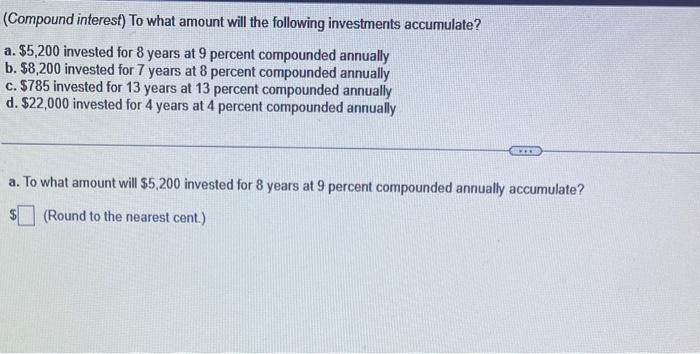
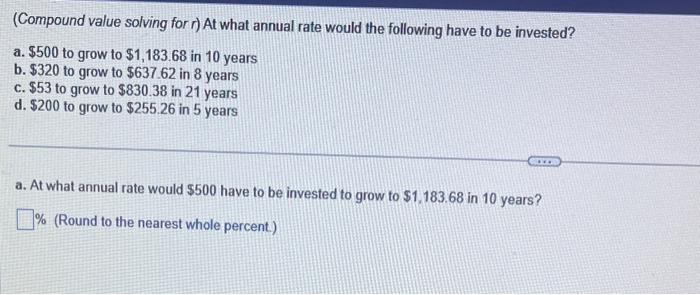

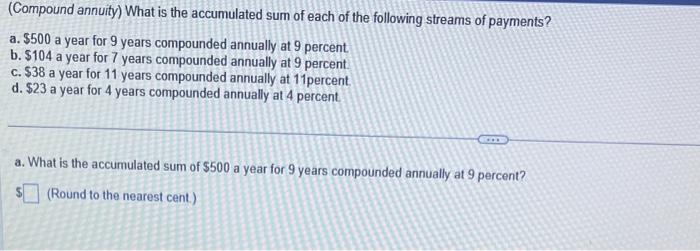







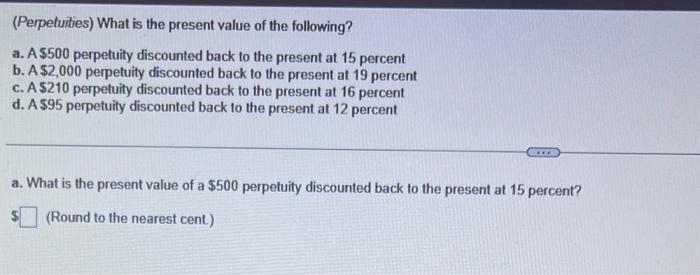





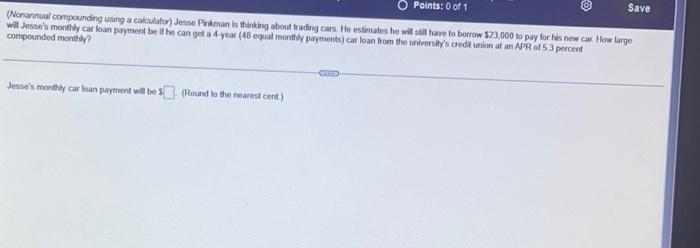

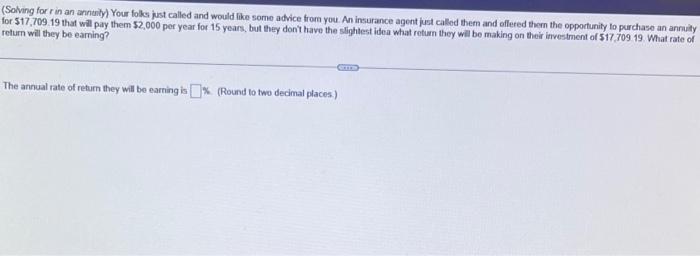

(Compound interest) To what amount will the following investments accumulate? a. $5,200 invested for 8 years at 9 percent compounded annually b. $8,200 invested for 7 years at 8 percent compounded annually c. $785 invested for 13 years at 13 percent compounded annually d. $22,000 invested for 4 years at 4 percent compounded annually a. To what amount will $5,200 invested for 8 years at 9 percent compounded annually accumulate? (Round to the nearest cent.) (Compound value solving for r ) At what annual rate would the following have to be invested? a. $500 to grow to $1,183.68 in 10 years b. $320 to grow to $637.62 in 8 years c. $53 to grow to $830.38 in 21 years d. $200 to grow to $255.26 in 5 years a. At what annual rate would $500 have to be invested to grow to $1,183.68 in 10 years? \% (Round to the nearest whole percent) (Present value) What is the present value of the following future amounts? a. $800 to be received 9 years from now discounted back to the present at 9 percent b. $300 to be received 7 years from now discounted back to the present at 9 percent c. $1,200 to be received 12 years from now discounted back to the present at 5 percent d. $1,150 to be received 6 years from now discounted back to the present at 20 percent a. What is the present value of $800 to be received 9 years from now discounted back to the present at 9 percent? \$ (Round to the nearest cent) (Compound annuity) What is the accumulated sum of each of the following streams of payments? a. $500 a year for 9 years compounded annually at 9 percent. b. $104 a year for 7 years compounded annually at 9 percent. c. $38 a year for 11 years compounded annually at 11 percent d. $23 a year for 4 years compounded annually at 4 percent. a. What is the accumulated sum of $500 a year for 9 years compounded annually at 9 percent? (Round to the nearest cent.) (Compound value) Stanford Simmons, who recently sold his Porsche, placed $9,400 in a savings account paying annual compound interest of 5 percent a. Calculate the amount of money that wili have accrued if he leaves the money in the bank for 3,6 , and 16 years b. If he moves his money into an account that pays 7 percent or one that pays 9 percent, rework part a using these new interest rates. c. What conclusions can you draw about the relationship between interest rates, time, and future sums from the calculations you have completed in this problem? a. What is the accrued value of $9,400 in a savings account paying annual compound interest of 5 percent for 3 years? (Round to the nearest cent) a. Calculate the future sum of 54,000. given that it will be held in the bank for 8 yoars at an APR of 5 percent. b. Recalculate part a using compoonding periods that are (1) semiannual and (2) bimonthly (cvery two months) c. Recalculate parts a and b for an APR of 10 percent d. Recalculate part a using a time hocizon of 16 yoars (the APR b still 5 percent) e. With respec to the effect of changes in the stated interest rate and holding periods on future sums in parts c and d what conclusions do you draw when you compare these figures with the answers found in parts a and b? a. What is the future sum of $4,000 in a bank account for 0 years at an APR of 5 percent? (Round to the nearest cent) Future volue) Sales of a new finance book were 18,000 coples this year and were expocted to increase by 24 percent per year. What are expected sales during each of the next 3 years? Graph this sales trend and explain a. If the 18,000 copios of book sales this year were expected to increase by 24 percent per year, what are the expected sales of the new finance book next year? coples (Round to the nearest unit) (Fufure value) Glancarlo Stanton hit 52 home runs in 2017 . If his home-fun output grew at a rate of 15 percent per year, what would it have been over the following 5 years? a. Giancarlo Stanton hil 52 home runs in 2017 , il his home-run output grew at a rate of 15 percent per year, what would it have been in 2018 ? hits (Round to the nearest unit) (Future value of an annuity) In 7 years, you are planning on retiring and buying a house in Oviedo, Florida. The house you are boking at currently costs 5110,000 and is expected to increase in value each year at a rate of 4 percent. Assuming you can eam 14 percent annually on your investments, how much must you invest at the end of each of the next 7 years to be able to buy your dream home when you retire? a. If the house you are looling at currenty costs 5110,000 and is expected to increase in value each year at a rate of 4 percent, what will the value of the house be when you retire in 7 yenars? (Round to the nearest cent) (Present value of an uneven stream of payments) You are given three investment allematives to analyze. The cash flows from these three investrnents are shown in the popup window Assuming a discount rate of 18 percent, find the present value of each irvestrient. a. What is the present value of investment A at 18 percent annual discount rate? (Round to the nearest cent) Present value) The Kumar Corporation is planning on issuing bonds that pay no interest but can be converted into $1,000 at maturity, 17 years from their purchase. To price thes these bonds? Kumar Corporation should sell these bonds at 5 (Round to the nearest cent) (Perpetuities) What is the present value of the following? a. A $500 perpetuity discounted back to the present at 15 percent b. A $2,000 perpetuity discounted back to the present at 19 percent c. A $210 perpetuity discounted back to the present at 16 percent d. A 595 perpetuity discounted back to the present at 12 percent a. What is the present value of a $500 perpetuity discounted back to the present at 15 percent? (Round to the nearest cent) Solving for r of an annenty) You lend a friend 535,000, which your friend will repay in 13 equal annual end-of-year payments of 55,000 , with the first payment to be received 1 yea rom now. What rate of return does your loan recehe? The rate of retum your loan will recetve is 15 . (Round to two docimal places). (Solving for in compound interest) You lend a friend $19,000, for which your friend will repay you $44,000 at the end of 11 years. What interest rate are you charging your friend? The interest rate you are charging your friend is 4. (Round to two decimal places.) (Compound annuity) You plan on buying some property in Florida 12 years from today. To do this, you estimate that you will noed 530.000 at that time foc the purchane Your would iken to accumulate these funds by making equal arneal deposits in your sarvhgs account, which pays 15 percent arnually, li you make your lest deposit at the end of this year, and you would like your account to reach 530,000 when the final deposit is made, what will be the amount of your deposits? The arnount of yout end-of year deposits wil be 1 (RRound to the nearest cent) (Complex present value) You would the to have $16,000ln15 years To accumulate this amount, you plan to deposit each year an equal sum in the bank, which will eam 9 percent interest compounded annualy Your first payment will be made at the end of the year a. How much must you deposk annualy to accumulate this amosint? b. If you decide to make a large lurnp-sume deposit today instead of the annual deposit, bow large should this lump- surn doposa be? (Assume you can eam 9 percent on this deposit.) c. At the end of 4 years you wil roceive 510,000 and deponit this in the bank toward your goal of $46,000 at the end of 15 years th addition to the doposit, how much must you depost in equal annual deposts to reach your goal? (Again assume you can eam 9 percent on this deposit) a. How much mmst you deposit annially to accumulate $46,000 in 15 yoars? (Round to the nearest cent) (Present value) The state lotery's millon-dollat payout provides for $3 milion(s) to be paid over 19 years in 20 payments of $150,000. The lirst $150,000 payment is made immediately, and the 19 remaining 5150,000 payments occur at the end at eachi of the ned 19 years if 12 percent is the appeopriate discouint rate, what is the present value of this strearn of cash flows? If 24 percent is the appropriate discount rade, what is the present value of the cash flows? a. If 12 percent is the appropriate diccourt rate, what is the present value of this stream of cath flows? (Round to the nearest cent) (Nonannual compounding using a calculator) Jesse Peviouan is thinking about trading cars. He estimates he wil stil have to borrow 523 , 000 to pay for his new car How large Wil Josse's monthly car loan payment be if he can get a 4 year ( 48 equal monthly payments) cal loan from the university's credit union at an APR of 53 percent compounded monthly? Jesseis monthly car loan payment will be 3 (Round to the nearest cent) (Complex annuty) Upon graduating from college 40 years ago, Dr. Nick Rivera was akeady thinking of tetirement. Since then, he has made deposits into his retirement fund on a weekly basts in the amount of \$25. Nick has just completed his firal payment and is at last ready fo retie. His retrement fund has eamed 10 . 1% interest campounded weekly a. How much has Nick accumilated in his retirement account? b. In addition to all this, 10 years ago, Nick received an irheritance check for 525,000 from his belored uncle He decided to deposit the entire arnount into hib refirement fund What is his current balance in the fund? a. Since graduating froen cologe 40 years ago, De Nick Riviera has made deposits lato his retirement fund on a woeldy basia in the arnount of 5.5 If his re6irement fund has eamed 10. 1\%. interest compounded weelly, how much has Nick accumulated in his retirement account? I (Round to the nearest cent) (Solving for r in an annenhy) Your folls just called and would like some advice from you. An insurance agent just called them and oflered them the opportunity to purchase an annilty for 517,709.19 that will pay them $2,000 per year for 15 years, but they dont have the slightest idea what return they will be making on their investment of 517 , 709 19. What rate of return will they be earning? The annual rate of return they will be earning is %. (Round to two decimal places). Solving for n) Jack asked Jill to marry him, and she has accepted under one condition: Jack must buy her a new $320,000 Rolls-Royce Phantom. Jack currentiy has 544,700 that he nay invest. He has found a mutual fund with an expectod annual return of 5.1% in which he will place the money. How long will it lake Jack to win Jils hand in marriage? Ignore The number of years it wil take for Jack to win Jilis hand in marriage is years (Round to one decimai place)



























